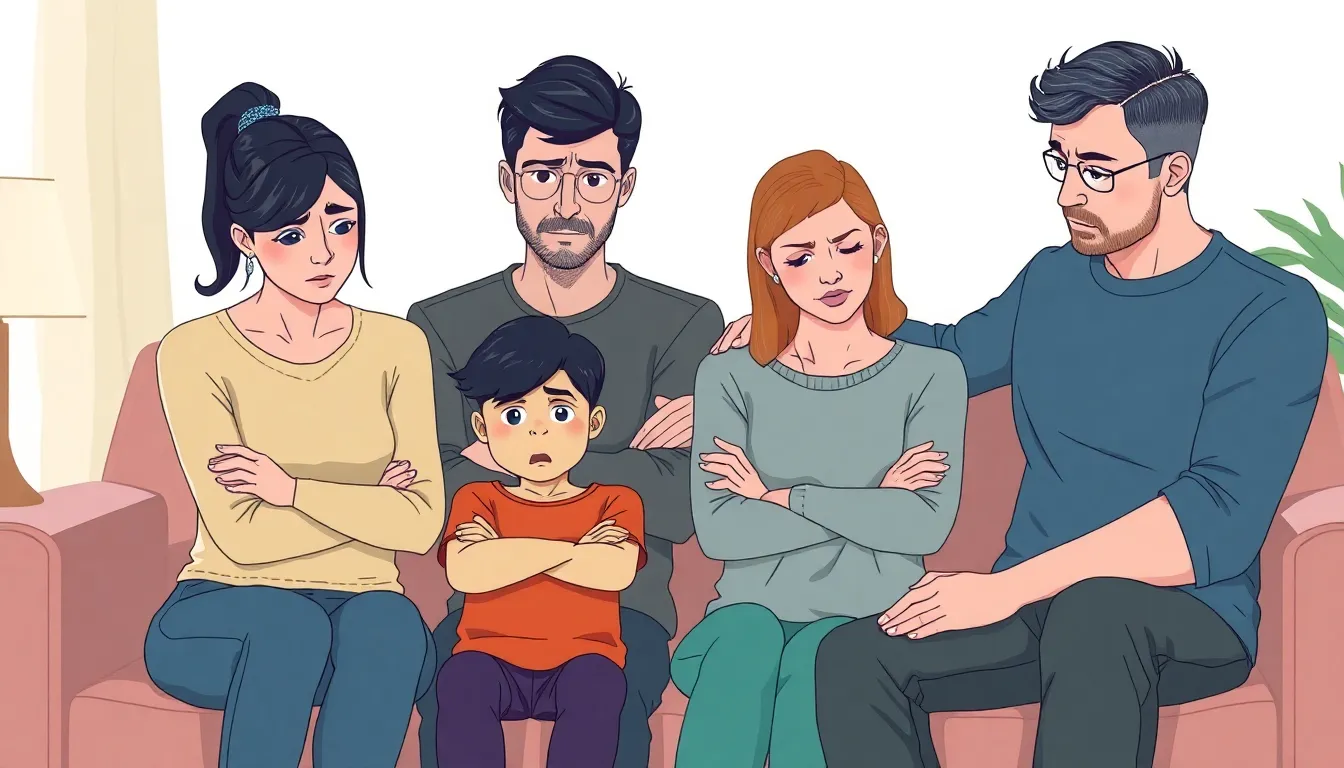In a world where selfies reign supreme and social media likes can feel like a currency, it’s no surprise that narcissism has crept into family dynamics. Imagine growing up in a household where the mirror gets more attention than the kids do. Welcome to the charmingly chaotic realm of narcissistic family dynamics, where love often comes with a side of manipulation and emotional acrobatics.
Navigating these relationships can feel like walking a tightrope—one wrong move and you might just fall into a pit of guilt trips and drama. But don’t worry, understanding these dynamics can empower anyone to reclaim their voice and sanity. So grab your emotional toolkit and let’s dive into the wild world of narcissism, where self-love takes center stage and everyone else is just part of the supporting cast.
narcissistic family dynamics
Narcissistic family dynamics create environments where manipulation often thrives. Recognizing these dynamics is crucial for fostering healthier interactions.
Defining Narcissism in Family Contexts
Narcissism in family contexts involves self-centered behaviors that disrupt relationships. It manifests through a lack of empathy from one or more family members. Family members may feel invalidated or unheard, affecting their sense of self-worth. These behaviors often stem from deeper psychological issues, leading to chaos and dysfunction within the family unit. Identifying narcissistic traits, such as grandiosity and entitlement, aids in understanding the dynamics at play.
Characteristics of Narcissistic Families
Narcissistic families exhibit several common characteristics. Emotional manipulation remains a cornerstone, with one family member often controlling interactions. Gaslighting tactics create confusion, making family members question their reality. Additionally, favoritism frequently emerges, causing sibling rivalry and resentment. Communication tends to focus on criticism rather than support, where achievements get overshadowed. Maintaining a constant façade of perfection becomes essential, leading to increased stress and anxiety among members. Recognizing these traits supports individuals in navigating the complexities of their relationships.
Impact on Family Members

Narcissistic dynamics profoundly affect family members, leading to emotional and psychological challenges.
Effects on Children
Children in narcissistic families often experience low self-esteem. They may face constant criticism, which undermines their confidence. Emotional neglect becomes common, leaving them feeling invisible. Some children adapt by becoming perfectionists or people pleasers to gain approval. Others may engage in rebellious behaviors, reflecting their struggle for autonomy. Long-term exposure to these dynamics can lead to anxiety or depression. Therapy addresses these issues, helping children regain their sense of identity and self-worth.
Influence on Spousal Relationships
Spouses in narcissistic families often find themselves in a cycle of emotional manipulation. Communication breaks down as one partner prioritizes their needs over the other. Feelings of frustration and resentment build up when support and validation are lacking. Some partners might feel trapped, juggling a desire for connection with the need for self-protection. Conflict escalation becomes common due to unaddressed grievances. Couples therapy offers a pathway to rebuild trust and improve understanding. Establishing boundaries stands as a key strategy for fostering healthier interactions.
Identifying Narcissistic Behavior
Recognizing narcissistic behavior is crucial for navigating complex family dynamics. This section outlines key indicators to identify narcissism effectively.
Signs of Narcissistic Parents
Narcissistic parents often display signs such as excessive self-centeredness. They tend to showcase an inflated sense of self-importance, requiring constant admiration. Emotional validation from their children rarely occurs as their needs overshadow those of the family. Frequent criticism and lack of empathy lead to children feeling invalidated. Additionally, favoritism surfaces in the form of attention, contributing to sibling rivalry. Children experience confusion due to inconsistent expectations and a lack of support, resulting in a struggle for approval.
Patterns of Enabling and Co-dependence
In a narcissistic family, enabling behaviors frequently emerge. Family members often prioritize the needs of the narcissistic individual, fostering co-dependence. They may overlook their own well-being in favor of maintaining peace or avoiding conflict. This dynamic creates an unhealthy cycle where individuals suppress their needs and emotions. Enablers frequently feel guilty for asserting themselves, reinforcing the narcissist’s behavior. Boundaries become difficult to establish, resulting in ongoing emotional turmoil for all parties involved. Recognizing these patterns is essential for breaking the cycle and promoting healthier family interactions.
Coping Strategies for Family Members
Coping with narcissistic family dynamics requires a strategic approach. Family members can adopt various methods to protect their well-being.
Establishing Boundaries
Establishing boundaries plays a vital role in maintaining mental health within narcissistic families. Define personal limits regarding acceptable behavior and communicate these clearly. Learn to say no without guilt; it’s essential to prioritize personal needs. Removing oneself from toxic interactions can help reduce stress. Recognize when demands exceed reasonable limits and address them directly. Family members must remain consistent in enforcing these boundaries to deter further manipulation or emotional turmoil.
Seeking Professional Help
Seeking professional help often provides essential support for navigating narcissistic family dynamics. Consulting therapists who specialize in family relationships can yield significant benefits. Therapy sessions create safe spaces to explore feelings and develop coping strategies. Engaging with support groups connects individuals with others facing similar challenges, reinforcing the understanding that they are not alone. Professionals can guide family members in rebuilding self-esteem and establishing healthier communication patterns. Investing in mental health is crucial for reclaiming identity and fostering resilience.
Healing and Recovery
Healing from narcissistic family dynamics involves proactive steps that promote personal growth and foster resilience. Recognizing the trauma inflicted by these relationships prompts individuals to take decisive actions toward recovery.
Steps Toward Personal Growth
Identifying core beliefs formed in childhood serves as a starting point for personal growth. Challenging negative self-perceptions brings clarity and encourages self-acceptance. Embracing self-care practices enhances emotional well-being and builds resilience. Setting achievable goals empowers individuals to reclaim their identities and promotes a sense of accomplishment. Engaging in mindfulness techniques helps manage anxiety and stress by fostering present moment awareness. Individual therapy provides a safe space to process experiences, facilitating deeper healing. Cultivating hobbies or interests encourages personal expression while expanding social circles.
Support Systems and Resources
Connecting with supportive individuals forms a crucial aspect of the healing process. Friends and family who understand the challenges can offer validation and encouragement. Peer support groups provide a sense of belonging and shared experiences, reducing feelings of isolation. Online communities also connect individuals facing similar challenges, offering empathy and advice. Professional resources, such as therapy or counseling, equip individuals with strategies to navigate family dynamics effectively. Books and workshops focused on healing from narcissism provide valuable insights and actionable strategies. Prioritizing self-discovery and emotional support creates a foundation for ongoing recovery and healthier relationships.
Conclusion
Navigating narcissistic family dynamics requires courage and a commitment to personal growth. By recognizing harmful patterns and establishing boundaries individuals can reclaim their sense of self and foster healthier relationships. Embracing support systems and seeking professional guidance can significantly enhance this journey.
Healing isn’t just about recovery; it’s about rediscovering one’s identity and fostering resilience. With the right tools and support individuals can break free from the cycle of narcissism and create a more nurturing environment for themselves and their loved ones. Prioritizing mental well-being is essential for thriving in the aftermath of these challenging dynamics.



